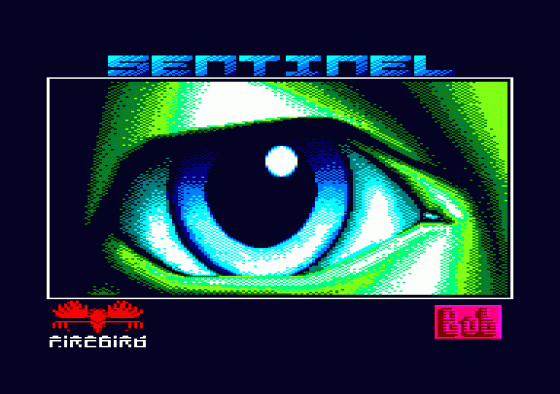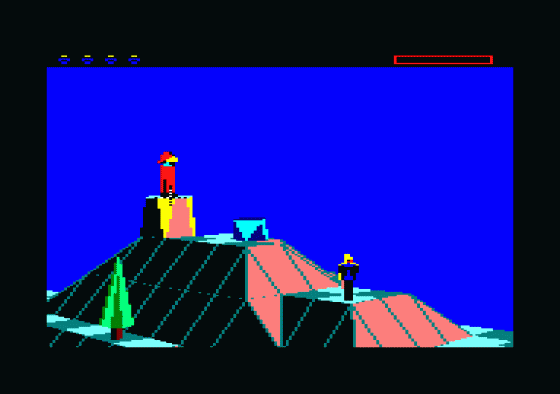
Amstrad Computer User
 1st April 1987
1st April 1987
Categories: Review: Software
Author: John Baker
Publisher: Firebird
Machine: Amstrad CPC464
Published in Amstrad Computer User #29
The Sentinel
John Baker ventures into a nightmare world of boulders, trees, guardians, meanies and... The Sentinel
When someone phones up and asks you to review a game with 10,000 levels a vague feeling of despair starts creeping in. Not another mega huge platforms and ladders job, surely? Or worse still, a 15-part multi-loader called something like Quest For The Sacred Keys Of Tharg, in which you play the mighty hero Norman, on whose equally mightly shoulders rests the entire fate of Pixiedom, and so on, and so on.
Worse still when they tell you it's a "totally new concept in gameplay... completely new... absolutely original".

Instinctively reaching for the Valium, suddenly unexpected hope springs forth when you hear the name of the author, Geoff Crammond. And when you actually get to play the game you sit there completely dumbfounded, because for once all the hype is true. That game is called The Sentinel.
Let's get a few things down for the record. The Sentinel is a totally new concept in gameplay. The Sentinel is also completely new. Astoundingly, it can also be described as absolutely original. And Geoff Crammond is the nearest thing the British games market has got to a genius.
Geoff made his name writing Aviator, a flight simulator for the BBC B, generally accepted as being the best on that format, but came to prominence only after the release of Revs on BBC B, then Commodore 64.

A motor-racing simulator par excellence, Revs confirmed Geoff as a major programming talent and a master of the 6502. And then came The Sentinel.
Originally released on the BBC B, quickly followed by the C64 version, it stunned the punters, picking up a host of awards. Now it's available on the CPC and it may not be bigger (you really want more than 10,000 levels?) but the good news is that it's better than ever before.
The Concept
The Sentinel is primarily a game of energy that pits you, an intelligence forced to dwell within robots of your own creation, in mortal combat with the Master of the Landscape, the Sentinel, standing on the highest point of the abstract Marble Madness style landscape where you find yourself imprisoned.

Geoff's strong science background comes out here. You expend energy to create objects, you gain energy by absorbing them. Robots, in which you can project your being at will, cost three units.
Boulders, which you can build in stacks - one of the primary strategies of the game - costs two. The lowest unit of energy is the tree, costing one unit. You start the game with ten.
The rules are quite simple. You can absorb the energy of any object you can see the base of, and to do that, you must be higher.

Creation is very much the same. You move around the landscape by creating a new robot, then transferring your "self" into it - the simple matter of pressing a button. You now see through its eyes.
To win the duel, you must absorb the Sentinel himself. This might sound easy but it's not, because the Sentinel has a deadly gaze.
As it rotates on a lofty pedestal its gaze scours the landscape like an invisible lighthouse, and if you are caught in that searchlight you are slowly drained of energy, unit by unit. Naturally, when you run out of energy you die.

Problem is that on many landscapes not only is there a Sentinel, but Guardians, beings with exactly the same powers, all slowly scanning the terrain.
When you get on a landscape with, say, six of them, what seems like a slow, albeit cerebral pastime, becomes faster and more furious than the most frantic shoot-'em-up, as you desperately search for somewhere to hide. If you are even slightly paranoid, this is not the game for you - it'll only confirm your worst fears!
The Game
The view on the screen is what you can see from the robot you are presently inhabiting. You may rotate or look up and down, although this may consume precious time.
The alien landscape - now more colourful than ever before - create an eerie atmosphere, and because the display puts you there, right in the middle of the action, the tension soon mounts as you dodge the gaze and try to work out a strategy that will allow you to destroy the Sentinel.
After the loading screen the program will ask you to enter a landscape number. If you input any number other than zero it will ask you for an entry code, an eight figure number.
You get them (and the CPC one's are different from the BBC and Commodore versions afraid) only by completing the level.
Once you have absorbed the Sentinel, you move to his plinth and then hyperspace. Now the number of units of energy you have left is added to the landscape number you have just departed from (say you are on landscape 10 and have five units of energy remaining: 10+5=15) and you are given the entry code for the landscape corresponding to that number, in this case, 15.
I estimate that taking a quarter of an hour per level, with an excess of 15 energy units at the end of each landscape (and that's good going) there is a good three months of non-stop play in the game. That's if you never get killed, of course.
I can see the eyes of a thousand budding hackers light up with the idea of cracking this coding system - but Mr Crammond himself says that he's made it very difficult to get into.
Once you input the correct code you wait a few moments, then the whole of the landscape is shown in 3D, with the position of the Sentinel and, if present, the Guardians. This gives you a once and only chance to study the terrain from an objective point of view and to start planning possible strategies, because once you're "inside" the landscape it looks very different.
What the display doesn't show you is your starting position, so don't make too many specific plans.
Once inside, for the only time in the game, you can relax. You can look around; take your time because the Sentinel won't start moving until you make a positive action, like absorbing or creating an object.
All action is controlled via the keyboard, and although at first there seem to be one hell of a lot of keys you'll soon find yourself getting used to it.
Press the spacebar, and a crosshair cursor appears, indicating where you can absorb/create things. Movement left and right is S/D; up and down, L/comma.
To absorb energy you move the cursor to the base of an object and press A. To create a tree, again at the point of the cursor, press T, for a boulder, B, a robot, R.
Q will transfer your "presence" to another robot, while H will hyperspace you to another location on the landscape (the same level, or lower) - but as it creates another robot at your new location, it'll cost you three energy points.
Lastly, U will turn you 180 degrees immediately, instead of waiting for the long scroll around (NB: Conservatives must never press this button, on pain of moving sharply to the left).
The moment you start doing something you'll hear the ominous boom of the Sentinel moving around. In the end it's a noise you'll have nightmares about.
The top right of the display will show when you are being scanned, it fills up with "snow" and a nerve-grating noise is emitted. Sometimes, however, because of the terrain, you'll only be half-scanned, so only half the display snows up. This is still bad news.
Although you won't be drained of energy, the Sentinel will look around for the nearest tree and convert it into a Meanie. This Meanie is a mini-sentinel that will try and scan you and, when it does, will automatically Hyperspace you. Which is bad news if you have less than three energy units left.
The Strategy
The game is all about getting higher than the opposition, then absorbing them. You might think this is difficult, considering you can't physically move, but the solution is quite easy.
What you do is to create a stack of boulders, create a robot on top of that, then transfer. Simple, huh?
Problem is, it's expensive in energy terms. Plus, when you start poking your head up above the mountains you become easier to scan.
Be aware of where the Sentinels/Guardians are, and which way they are rotating. This is difficult, particularly if there are more than three to worry about. You must carry a picture of the complete landscape in your head, and imagine where the safe spots are - and how long they are likely to stay that way. This makes your brain hurt at first, but is vital for success.
Be careful with your energy supply, but don't be afraid of being bold when you think you have a chance to strike decisively.
You can always pick up extra energy by absorbing the surrounding trees. Another neat aspect to the game incidentally, the energy within the landscape is constant, so if you or one of the artefacts you left behind is scanned, the energy is not destroyed, but distributed as the lowest form of energy, trees, randomly about the system.
It is vital to absorb your old body, plus any boulders you were standing on, when you transfer. Failure to do so will cost you a lot of energy.
Finally, remember that you can create trees, as well as boulders and robots. They can be used to block the energy-draining stare of the opposition.
The Conclusion
Sentinel is a game of unique qualities. It requires intelligence, quick thinking and an agile brain. It is not the fastest game in the world, some might find the scrolling as you view too slow in fact, but this only serves to build up the tension that increases as you get nearer your goal.
There's more life in it than most - and it's a game that you'll find yourself coming back to again and again. It's frustrating, it's infuriating, it's challenging as hell.
The Sentinel confirms Geoff Crammond as one of Britain's foremost game designers. If only he played football.
Other Reviews Of The Sentinel For The Amstrad CPC464
Sentinel (Firebird)
A review by Bob Wade (Amstrad Action)




